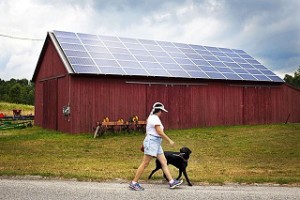From Guest Blogger Emily Folk: How Europe Is Revolutionizing Renewable Energy

The share of renewable energy production in the European Union as a whole reached 16.4 percent in 2015, and the EU is aiming for a higher share. Here’s how they do it.
Renewables on the Rise
Of all the energy capacity the EU added to its electric grids in 2016, 86 percent was from renewable resources. Wind energy even surpassed coal as Europe’s second-biggest source of electricity, beaten out only by natural gas. Because the wind is intermittent, though, coal still met more energy demand.
Solid biofuels and renewable waste, burning trash and organic matter for fuel, was the most common renewable energy source in Europe in 2014, followed by hydropower, wind and solar. Wind and solar saw a significant increase in installation though, especially with the rise of offshore wind farms. Germany produced the most renewable energy, followed by Italy and France.
Europe is focusing the vast majority of its new installations on renewable energy resources, which is helping it lead the way when it comes to clean energy.
Stronger Energy Policies
Public support for climate action is strong in the EU, and public policy reflects that. France, for instance, is taking some big steps toward a clean energy future.
France is planning to gradually stop granting new licenses for oil and natural gas exploration, which is just part of its renewable energy efforts. The country’s Environmental Transition Minister Nicolas Hulot says he wants to increase taxes on diesel, and French President Emmanuel Macron is working on a plan to help French people reduce the amount of energy they consume in their homes.
Other EU countries are also implementing aggressive renewable energy policies, which are accelerating the transition to an energy landscape that relies more heavily on renewables.
Aiming High
What drives these energy policies and investment in new renewable energy capacity is the targets for renewable energy use set by the EU and its member nations.
The EU’s renewable energy directive set a binding target of 20 percent renewables by 2020 and a new target of at least 27 percent by 2030. In order to meet these targets, individual EU countries have set their own targets. Some have gone above and beyond the required amount, such as Sweden, which has set for itself a target of 49 percent by 2020.
In addition to national and EU plans, Europe is also a part of the Paris climate accord—an agreement between the majority of the world’s nations aimed at reducing emissions and stopping global temperatures from rising. This also factors into the EU’s emphasis on renewable energy.
The European Union is certainly leading the way when it comes to renewable energy. Other countries, including China, the United States and Costa Rica, are making significant progress on renewables as well. That’s important because transitioning to clean, renewable energy that’s better for the planet and energy security is a challenge that’s going to be difficult to meet. It will require contributions from nations all around the world.
About the Author
Emily Folk is a freelance writer and blogger from Lancaster, PA. She covers topics in conservation, sustainability, and renewable energy. To see her latest posts, check out her blog Conservation Folks, or follow her on Twitter!

Emily,
It’s nice to see you are passionate about Renewable Energy.
However, without wishing to dampen you enthusiasm, perhaps you should do a little more research beyond “gee whiz” type articles and press releases from Renewable Energy lobbyists.
The PRC (China) continues to build a massive new coal fired power plant every 10 days, and will for the next 5 years taking their total to almost 1000 enormous coal fired power plants.
Germany achieves it’s advertised figures by an almost incomprehensible labyrinth of complex accounting and transactions devised to distort and how it’s power is derived. It’s renewable achievements are largely illusory.
Costa Rica is a tiny nation lacking any industrial consumption and blessed with ample Hydro electric power. Since only 58% of Costa Rica is connected to the grid, and the local population (excluding foreign residents) earns less than $7000 per year, your cheery little article would appear at the best naive and at the worst somewhat cruel.
You also should check to see how much bio-mass, and what sort of bio-mass is concealed as “renewable” before you getting so excited about the environmental benefits of “renewable”.
Emily, it’s great to be enthusiastic and a passionate renewable supporter, but a little critical analysis might give your enthusiasm more credibility.
Emily,
Here’s an excellent example of the problems experienced by trying to combine intermittent sources of power with conventional sources.
The US state of Texas is one location where Wind farms are more economically relevant (nearly 18% of the state electricity is renewable).
However, despite a truly massive scale of investment by taxpayers and consumers as the as the heat builds this week and keeps turbines from spinning less electricity will be generated, right when it’s needed most. Wind generation will drop by as much as two-thirds.{source; Electric Reliability Council of Texas/Ercot]
Even when offset by a slight increase in offshore output, the loss is very significant.
Fossil-fuel generators such as coal and natural gas plants step up to help meet demand. This is not only expensive, but requires expensive wear and tear of grid infrastructure.
Nor are fossil fuel plants deigned to be constantly ramped up and down. Generation is most efficient when the power plants can run a ‘cruising’ speed needing only minor adjustments.
The economics are not helped by being forced to integrate a number of different and non compatible sources of power generation. It can be done, but not without hidden losses and economic consequences.
Power generation is a complex business. It’s not helped by choosing one technology for philosophic, political or ideological reasons.
Constantly loading the dice to favour one technology over another is unsustainable.